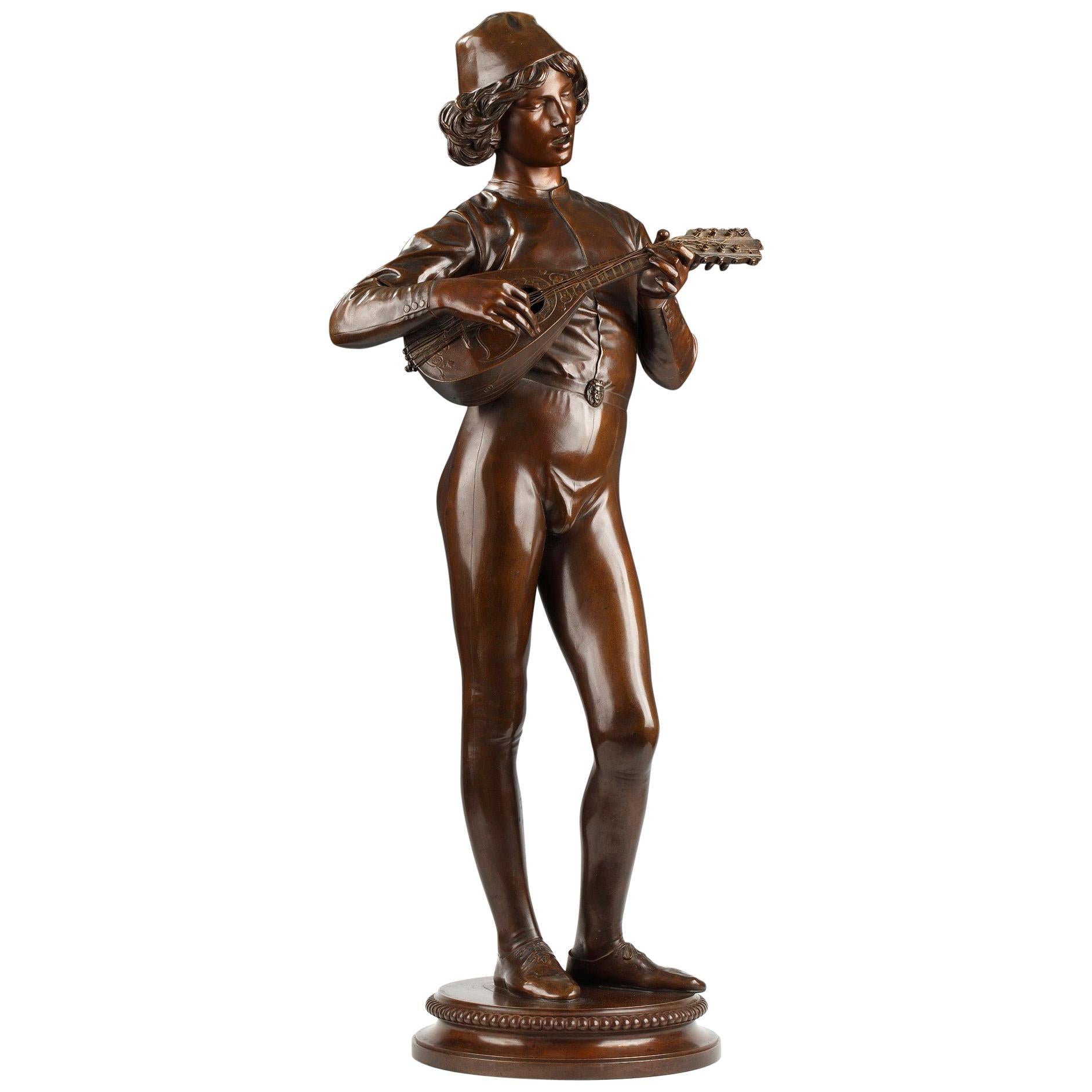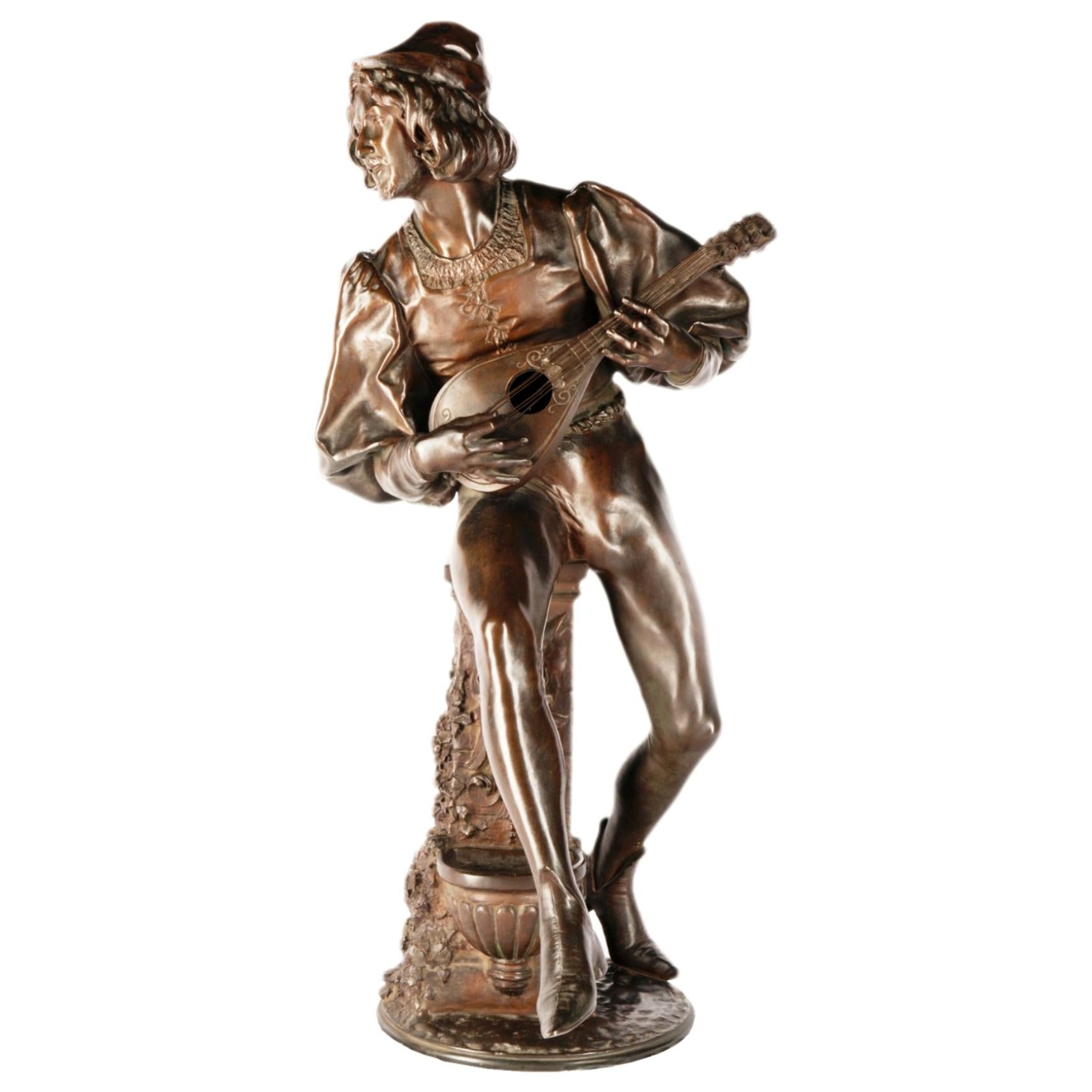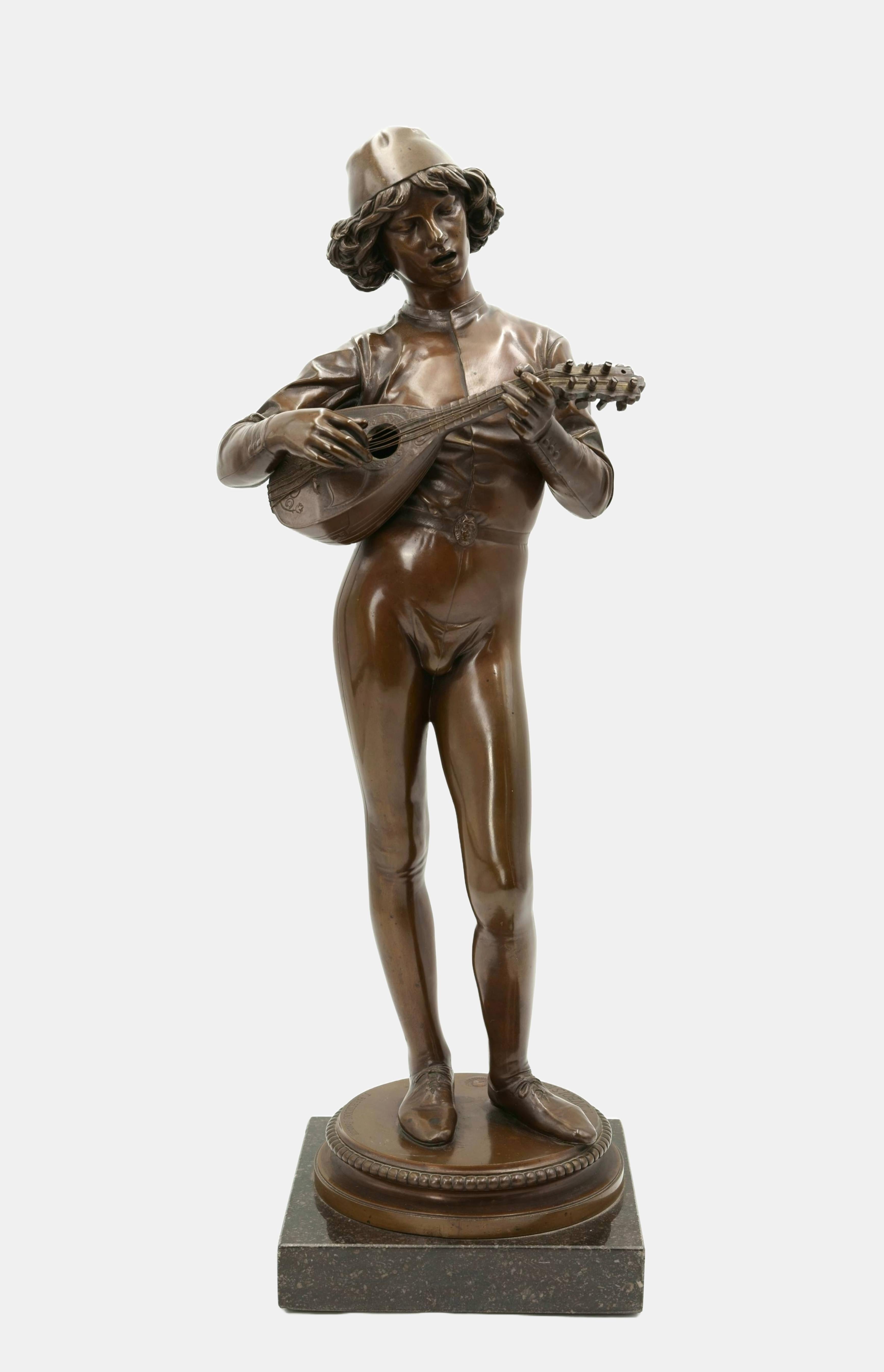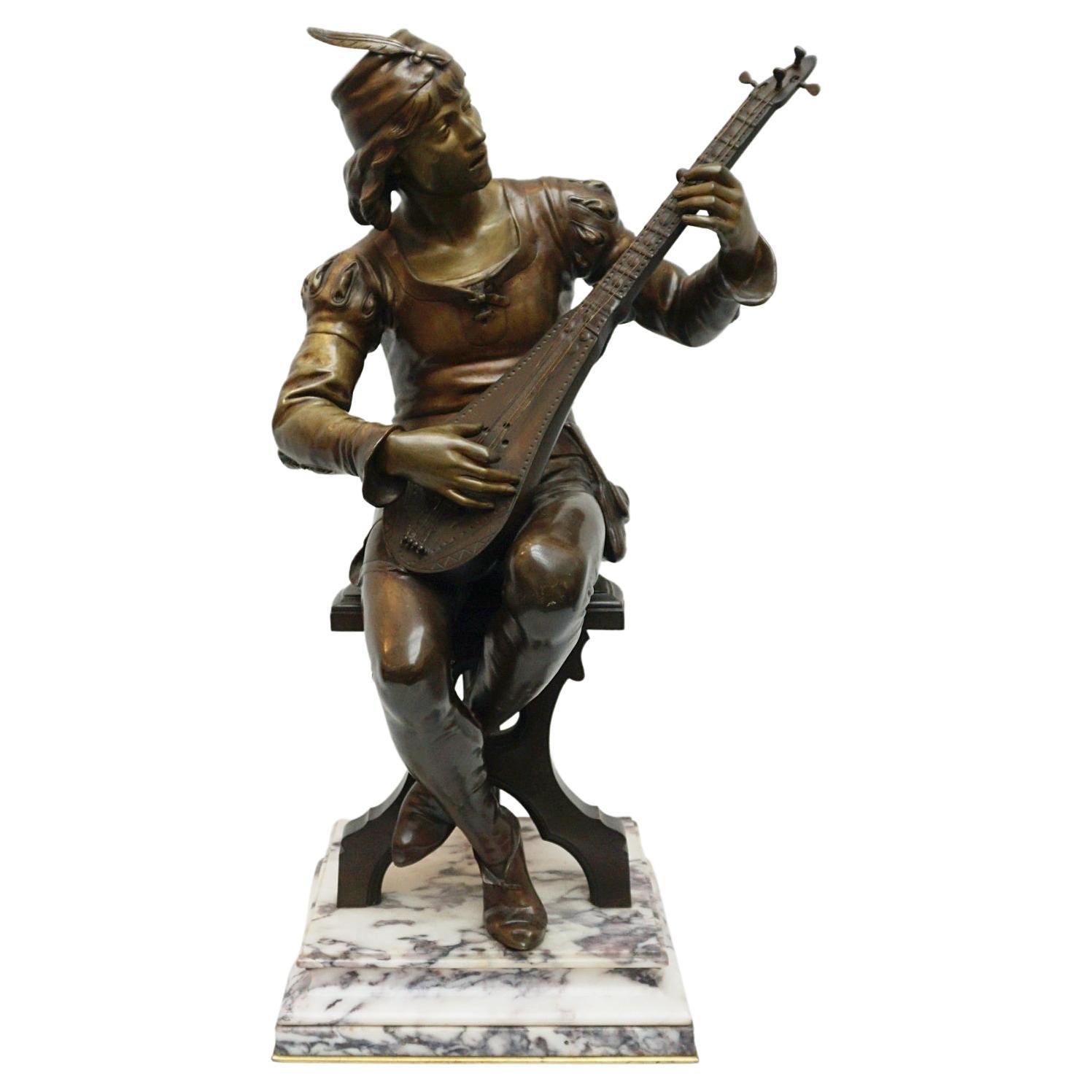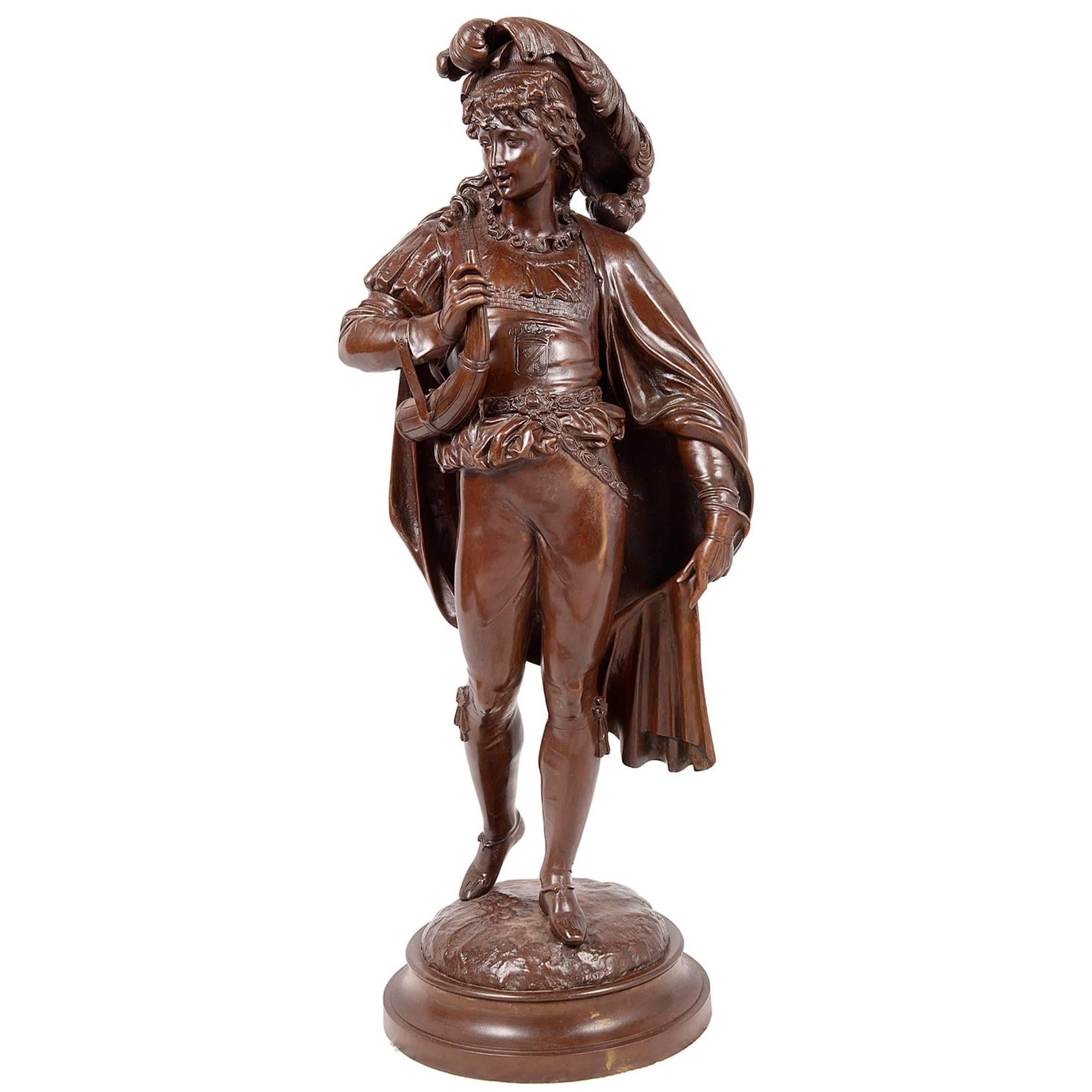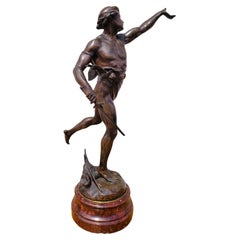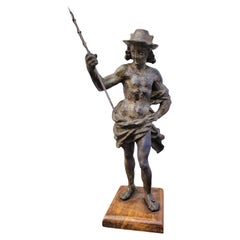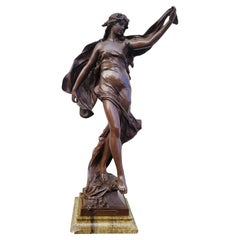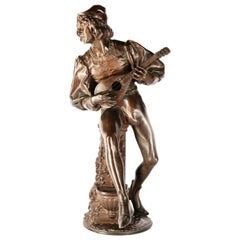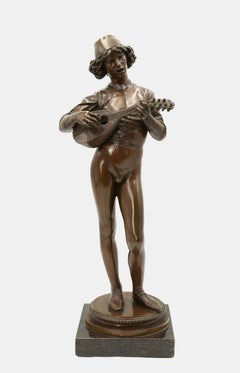Items Similar to Paul Dubois, The Florentine Singer Of The 15th Century, Signed Bronze, 19th Cent
Video Loading
Want more images or videos?
Request additional images or videos from the seller
1 of 22
Paul Dubois, The Florentine Singer Of The 15th Century, Signed Bronze, 19th Cent
$7,127.43
£5,297.72
€6,000
CA$9,893.27
A$11,098.38
CHF 5,738.19
MX$133,852.55
NOK 73,001.81
SEK 68,373.12
DKK 45,675.85
About the Item
Large double patina bronze representing the Florentine Singer of the 15th century, signed P Dubois Fr
The young and elegant boy, standing, plays and sings, leaning against a column: the sculptor paid all his attention to many details, in the clothing (shoes, buttons ...) the musical instrument ...
Paul Dubois, born in 1869, is a French sculptor studying at the Beaux Arts in Paris then in Rome. Impressed by Italian Renaissance sculpture, he will be the leader of the so-called "Florentine" sculptors.
The Florentine Singer of the 15th century will be presented at the Salon of 1865, will obtain the medal of honor and will become one of the most popular sculptures of that time.
The Florentine Singer will be published in several dimensions and patinas: one of them is exhibited at the Louvre Museum, in silver-plated bronze.
Wear of time to the patina
Height: 88cm
diameter approx. 33cm
- Creator:Paul Dubois (Artist)
- Dimensions:Height: 34.65 in (88 cm)Diameter: 13 in (33 cm)
- Style:Renaissance (In the Style Of)
- Materials and Techniques:
- Place of Origin:
- Period:
- Date of Manufacture:unknown
- Condition:Wear consistent with age and use. Minor losses. Minor structural damages. Minor fading.
- Seller Location:MARSEILLE, FR
- Reference Number:1stDibs: LU6656243490022
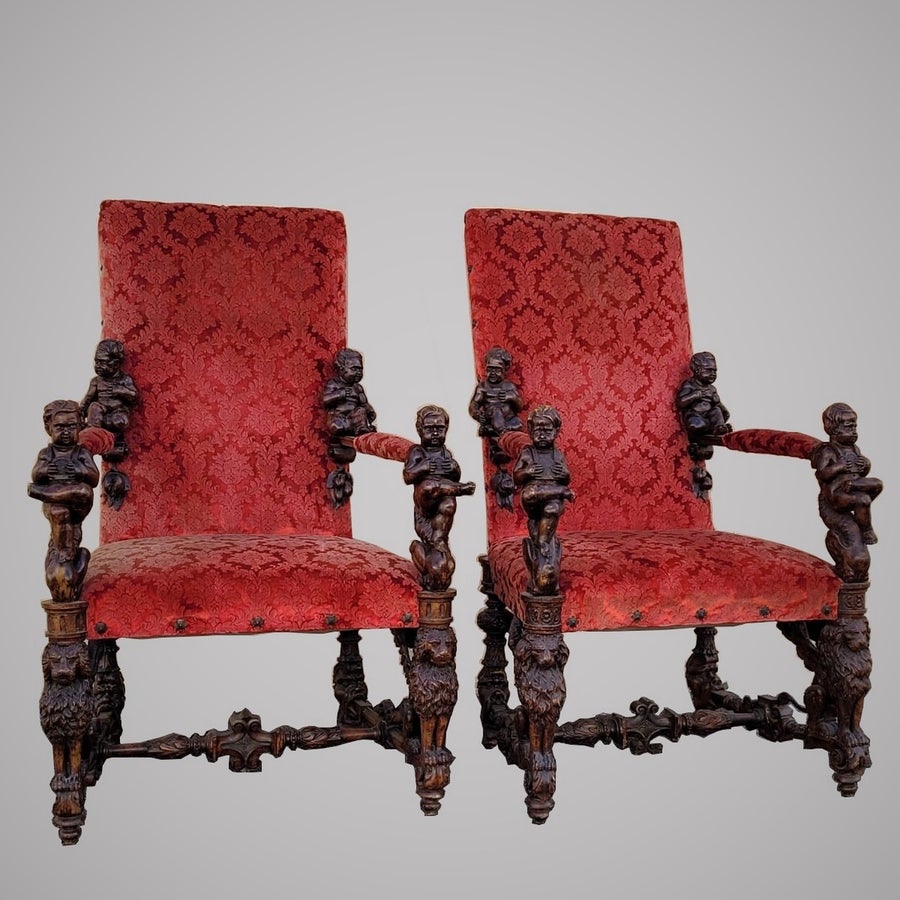
About the Seller
5.0
Vetted Professional Seller
Every seller passes strict standards for authenticity and reliability
Established in 1999
1stDibs seller since 2022
25 sales on 1stDibs
Typical response time: 5 hours
- ShippingRetrieving quote...Shipping from: MARSEILLE, France
- Return Policy
Authenticity Guarantee
In the unlikely event there’s an issue with an item’s authenticity, contact us within 1 year for a full refund. DetailsMoney-Back Guarantee
If your item is not as described, is damaged in transit, or does not arrive, contact us within 7 days for a full refund. Details24-Hour Cancellation
You have a 24-hour grace period in which to reconsider your purchase, with no questions asked.Vetted Professional Sellers
Our world-class sellers must adhere to strict standards for service and quality, maintaining the integrity of our listings.Price-Match Guarantee
If you find that a seller listed the same item for a lower price elsewhere, we’ll match it.Trusted Global Delivery
Our best-in-class carrier network provides specialized shipping options worldwide, including custom delivery.More From This Seller
View AllRuffony, The Oath, Signed Bronze Sculpture, Late 19th Early 20th Century
By Ruffony
Located in MARSEILLE, FR
The Oath: bronze sculpture with a brown patina, of a young man, sword in hand, taking an oath
The round base is titled and signed by the artist: Oscar Ruffony. Swiss sculptor, but a...
Category
Antique Late 19th Century French Napoleon III Figurative Sculptures
Materials
Bronze
E Picault, Victoria, Bronze Sculpture, Late 19th Century
By Émile Louis Picault
Located in MARSEILLE, FR
Victoria: bronze sculpture with a brown patina of a victorious warrior, on a red marble base
This bronze is entitled "Victoria" and is signed by the artist Emile Picault
Emile Pica...
Category
Antique 19th Century French Napoleon III Figurative Sculptures
Materials
Marble, Bronze
Cast Iron Mercury Statue
Located in MARSEILLE, FR
Representation of Mercury in cast iron on a wooden base: Mercury (Roman God) or Hermes (Greek God), the messenger god of the other gods is recognizable here thanks to the caduceus he...
Category
Antique 18th Century European Greco Roman Figurative Sculptures
Materials
Iron
$2,019
E Marioton, Pompeian Dancer, Signed Bronze, Late 19th Early 20th Century
By Eugene Marioton
Located in MARSEILLE, FR
Large bronze dancer with a brown patina, on a green marble base: she bears the name of Pompeian Dancer on a cartouche. She plays delicately with her veil, balanced on one foot, on a ...
Category
Antique Late 19th Century French Art Nouveau Figurative Sculptures
Materials
Bronze
Carrier-belleuse, Cigale, Large Signed Bronze, 19th Century
By Albert-Ernest Carrier-Belleuse
Located in MARSEILLE, FR
"Cigale" large bronze with brown patina of a mandolin player, leaning against a wall
This sculpture is titled and signed A Carrier-Belleuse
Beautiful patina and good quality of wor...
Category
Antique 19th Century French Napoleon III Figurative Sculptures
Materials
Bronze
U Rusconi, Medusa, Signed Bronze, Late 19th Early 20th Century
Located in MARSEILLE, FR
Medusa: bronze with a brown patina, relating the myth of the gorgon or Medusa
According to mythology, Medusa is a beautiful young woman who made a vow to serve the goddess Athena, ...
Category
Antique Late 19th Century Italian Napoleon III Figurative Sculptures
Materials
Bronze
You May Also Like
"Florentine Singer" Bronze Sculpture by P. Dubois and F. Barbedienne, Circa 1880
By Paul Dubois, Ferdinand Barbedienne
Located in PARIS, FR
Signed P. Dubois 1865 and F. Barbedienne fondeur
Stamped with réduction mécanique Collas
A patinated bronze « Florentine Singer » sculpture, inspir...
Category
Antique 1880s French Figurative Sculptures
Materials
Bronze
19th Century Bronze Statue of a Minstrel, Signed Paul Fournier
By Paul Fournier
Located in Brighton, Sussex
Paul Fournier (French, 1859-1926): A large bronze figure of a minstrel playing a lute the figure in Renaissance dress, looking to dexter and seated o...
Category
Antique 19th Century French Renaissance Figurative Sculptures
Materials
Bronze
19th Century, Barbedienne, Bronze Statue of a Minstrel
By F. Barbedienne Foundry
Located in Brighton, Sussex
A very good quality 19th Century Bronze statue of a minstrel player, signed Barbedienne.
Category
Antique 19th Century Figurative Sculptures
Materials
Bronze
Florentine singer / - The Renaissance of the Renaissance -
By Paul Dubois
Located in Berlin, DE
Paul Dubois (1829 Nogent-sur-Seine - 1905 Paris), Florentine singer, 1865. Light brown patinated bronze with cast round plinth mounted on a square marble base (3.5 cm high). Total height 53 cm. Bronze dimensions: 49.5 cm (height) x 20 cm (length) x 10 cm (width), weight 5.6 kg. Inscribed on the plinth "P.[aul] DUBOIS", dated "1865", with the foundry's mark "F. BARBEDIENNE FONDEUR" and the signet "REDUCTION MECANIQUE A. COLLAS".
- Patina very occasionally darkened, lute with loss of one tuning peg, otherwise in excellent condition.
- The renaissance of the Renaissance -
The bronze is a precisely executed and masterfully cast contemporary reduction of Paul Dubois 155 cm tall masterpiece "Florentine Singer", which is exhibited in the Musée d'Orsay and for which the artist was awarded the Medal of Honor at the Paris Salon in 1865. The work acted as a beacon, and was followed by a plethora of depictions of juveniles.
Inspired by Donatello and Luca della Robbia, but also by painters such as Piero della Francesca, Benozzo Gozzoli, and Pinturicchio, the "Florentine Singer" is not an epigonal work that pays homage to a vanished era, but a successful attempt to draw vitality from the art of the past and thus give it new life.
The effect of vitality is the core of Italian Renaissance art theory. In order to fulfill itself as art, art had to appear like nature. This naturalism also characterizes the "Florentine Singer". The young man appears to have been taken from life, which is reinforced by the momentary nature of his action. He has just struck a now fading chord. In addition, the natural appearance is enhanced by the detailed shaping of the figurative details, such as the laces with the slightly curved leather of the shoes, the belt buckle, or the ornamentation on the body of the lute. Even the fingernails are clearly defined. Unlike the Renaissance, however, the effect of liveliness here is not based on the "discovery" of nature and the human body, but primarily on the rediscovery of the art of the Quattrocento. The liveliness of the artwork is therefore at the same time a revitalization of this art, so that we can speak of a Renaissance of the Renaissance, just as the Pre-Raphaelites in England at the same time transferred the Quattrocento to contemporary art.
Dubois takes on the most difficult of all subjects, the depiction of singing through silent sculpture. He was preceded in this by Luca della Robbia and Donatello with their pulpits of singers created in the 1430s in the Museo dell'Opera del Duomo in Florence. Compared to these works, the physiognomy of Dubois singer is far less animated, yet he also depicts singing in a convincing manner. He uses the whole body. He takes the ancient contrapposto, which was essential to Renaissance sculpture, and transforms the standing leg-playing posture into a late medieval S-swing, giving the body an elegant beauty and at the same time setting it in melodic motion. In the equally elegant finger position, the music is expressed in a much more literal way with the beating of the lute. Finally, the musicality of the sculpture culminates in the face with the mouth open to sing.
Through the act of singing, which is a great challenge to the artistic will to depict perfect beauty, the gracefulness of the classical face is not diminished, but enhanced. Starting from the face with the singing mouth and the gaze absorbed by the sounds, the inner vitality spreads, giving the bronze sculpture an intense aura, enhanced by the music. Dubois transfers the beauty of the Renaissance to the musical, sublimating the visible sculpture to the invisible of music.
He took up the challenge of transcending the Renaissance with the Renaissance, thus responding to the Querelle des Anciens et des Modernes, which arose at the end of the 17th century around the French Academy and remained virulent into the 19th century, in which antiquity was regarded either as an unattainable ideal or as a standard to be surpassed. With his work, Dubois proved that the Renaissance, which had championed the art of the ancients, could lead to a new renaissance of art.
About the artist
Paul Dubois' great-uncle was the famous French Baroque sculptor Jean-Baptiste Pigalle, in whose footsteps the talented great-nephew followed. When he debuted at the Paris Salon in 1858, he signed his work "Dubois-Pigalle". At his father's request, however, he first studied law before devoting himself to sculpture under the tutelage of François Christophe Armand Toussaint in 1856 and entering the École des Beaux-Arts in 1858. From 1859 to 1863, he lived in Rome and traveled to Naples and Florence. Inspired by Florentine art of the quattrocento, Dubois initiated a school-forming neo-Florentine style that combined the elegantly simple forms of youthful grace with a precise wealth of detail.Two purchases by the French state (“envois de Rome”) were made during his stay in Rome, which brought him recognition in Paris. After his return there, he quickly became an internationally sought-after artist.
Dubois was also active as a creator of monuments. His most famous work is the equestrian statue of Joan of Arc (1896) on the forecourt of Reims Cathedral. He was also a sought-after portraitist who produced around 50 busts and - Dubois was also a passionate painter - around 100 portraits in oil.
From 1873 to 1878 he was curator of the Museum du Luxembourg, in 1876 he became a member of the Institut de France and from 1878 to 1905 he was director of the École des Beaux-Arts.
In 1865, Dubois was awarded the Paris Salon Medal of Honor for his “Florentine Singer”. In 1867 he became Chevalier, in 1874 Officier, in 1886 Commandeur of the Légion d'honneur, which awarded Dubois the Grande Croix in 1896.
Selected Bibliography
Stole, Elmar: Paul Dubois. In: Saur. Allgemeines Künstlerlexikon, vol. 30, Munich - Leipzig 2001, pp. 677-678.
GERMAN VERSION
Paul Dubois (1829 Nogent-sur-Seine - 1905 Paris), Florentinischer Sänger, 1865. Hellbraun patinierte Bronze mit gegossener runder Plinthe auf quadratischem Marmorsockel montiert (3,5 cm Höhe). Gesamthöhe 53 cm. Maße der Bronze: 49,5 cm (Höhe) x 20 cm (Länge) x 10 cm (Breite), Gewicht 5,6 kg. Auf der Plinthe mit „P.[aul] DUBOIS“ bezeichnet, auf „1865“ datiert, mit dem Gießereistempel „F. BARBEDIENNE FONDEUR“ und dem Signet „REDUCTION MECANIQUE A. COLLAS“ versehen.
- Patina sehr vereinzelt nachgedunkelt, Laute mit Verlust eines Stimmwirbels, ansonsten ausgezeichnet erhalten.
- Die Renaissance...
Category
1860s Realist Figurative Sculptures
Materials
Bronze
$4,276 Sale Price
20% Off
'Seated Minstrel' a Late 19th Century Bronze Sculpture by Emile Boisseau
Located in Forest Row, East Sussex
'Seated Minstrel' A late 19th century bronze sculpture by Emile Boisseau (1842-1923) depicting a seated Troubadour in traditional costume playing the lute. Rich light brown patina. S...
Category
Antique Late 19th Century French Late Victorian Figurative Sculptures
Materials
Bronze
19th Century Bronze Statue of a Courtier by Duboy
By Paul Duboy
Located in Brighton, Sussex
A very good quality 19th century bronze statue of French courtier, with a feather hat, cloak and horn.
Signed; Duboy
Paul Duboy (1830-1887).
Category
Antique 19th Century French Figurative Sculptures
Materials
Bronze
More Ways To Browse
15th Century Italian
15th Century Bronze
Antique Singer
Large Gold Buttons
Italian Renaissance 15th Century
Antique Clothing Museum
Singer Antique Furniture
Antique French Buttons
Plates Italian Florentine
Antique Silver Shoes
Plate 1865
Antique Silver Buttons
Dubois Bronze
High Point Bending Company Chair
Murano Glass Jellyfish
White Porcelain Statue
Aphrodite Marble
Austrian Nude Ceramic
